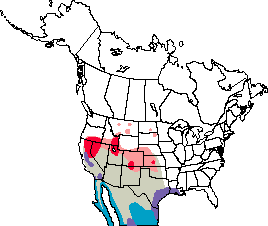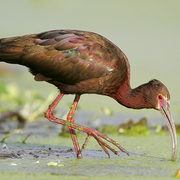White-faced Ibis
Plegadis
chihi
Ciconiiformes
The herons, ibises and allies are large birds, most with long legs and necks. Many live on or near water where they wade in search of prey. Many breed in colonies. This order has five families worldwide, of which two are represented in Washington:
Threskiornithidae
The ibises are long-legged, long-necked wading birds that look superficially like herons. Their feeding styles, however, are very different. They are mostly tactile feeders, and use their long, often decurved bills to probe in shallow water or mud for invertebrates or small vertebrates. They generally inhabit wetlands, but some forage in upland fields or along densely forested rivers. They are sociable in all seasons, feeding in flocks, and nesting in colonies. They fly with their necks fully extended, and flocks often congregate in lines or V-formations and may flap and glide in unison. They begin breeding at two to four years and are monogamous, but pair bonds last a single season. Both members of the pair help build bulky platform nests, incubate two to four eggs, and feed the young, which stick their heads into the adults' mouths and feed on partly digested food. Some species in this group are migratory, and others are resident.
General Description
Rare and probably increasing visitor on both sides of Cascades, mostly May'July. Sometimes appears in large flocks.
 Abundance
Abundance
| Ecoregion | Jan | Feb | Mar | Apr | May | Jun | Jul | Aug | Sep | Oct | Nov | Dec |
|---|---|---|---|---|---|---|---|---|---|---|---|---|
| Oceanic | ||||||||||||
| Pacific Northwest Coast | ||||||||||||
| Puget Trough | ||||||||||||
| North Cascades | ||||||||||||
| West Cascades | ||||||||||||
| East Cascades | ||||||||||||
| Okanogan | ||||||||||||
| Canadian Rockies | ||||||||||||
| Blue Mountains | ||||||||||||
| Columbia Plateau | R | R |
North American Range Map






